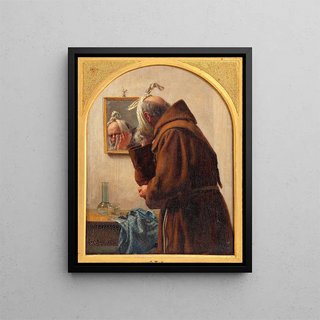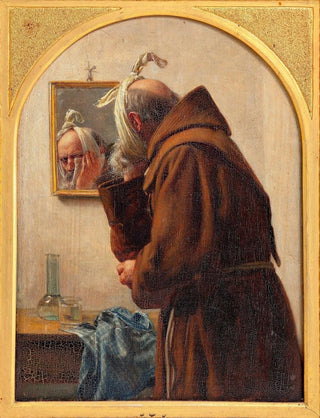Painting A monk examines himself in a mirror - Carl Bloch | Art print


View from behind

Frame (optional)
Art print Un monk examines himself in a mirror - Carl Bloch – Captivating introduction
In the fascinating universe of art, some works transcend the mere frame to invite deep reflection on the human condition. "Un moine s'examine dans un miroir" by Carl Bloch is one of those pieces that, through its composition and subject, sparks delicate introspection. This painting, both poignant and evocative, transports us to an intimate moment where spirituality and contemplation meet. Through the monk's gaze, we are invited to explore themes of faith, duality, and identity, while questioning our own relationship with ourselves and our environment.
Style and uniqueness of the work
Carl Bloch, master of romantic realism, succeeds in capturing the very essence of the human soul in this piece. The monk, immersed in deep thought, stands before a mirror that reflects not only his image but also his thoughts and doubts. The carefully orchestrated play of light and shadow gives the scene an atmosphere that is both serene and unsettling. The meticulous details, from the folds of the man's robe to the reflections in the mirror, demonstrate technical virtuosity characteristic of Bloch's work. The color palette, dominated by warm and earthy tones, enhances the impression of human warmth and spirituality, while the monk's posture, both humble and introspective, evokes a personal quest for truth.
The artist and his influence
Carl Bloch, born in Denmark in 1834, managed to carve out a prominent place in the art world thanks to his ability to blend tradition and innovation. Influenced by the great masters of painting, he developed a style that is uniquely his own, combining realism and romantic sensitivity. His works, often imbued with religious themes, reflect a deep understanding of human nature and the inner struggles that accompany it. Bloch was also a pioneer in using light to emphasize emotions, a technique that inspired many artists after him. His legacy endures, and "Un moine s'examine dans un miroir" remains a perfect illustration of his ability to

Matte finish

View from behind

Frame (optional)
Art print Un monk examines himself in a mirror - Carl Bloch – Captivating introduction
In the fascinating universe of art, some works transcend the mere frame to invite deep reflection on the human condition. "Un moine s'examine dans un miroir" by Carl Bloch is one of those pieces that, through its composition and subject, sparks delicate introspection. This painting, both poignant and evocative, transports us to an intimate moment where spirituality and contemplation meet. Through the monk's gaze, we are invited to explore themes of faith, duality, and identity, while questioning our own relationship with ourselves and our environment.
Style and uniqueness of the work
Carl Bloch, master of romantic realism, succeeds in capturing the very essence of the human soul in this piece. The monk, immersed in deep thought, stands before a mirror that reflects not only his image but also his thoughts and doubts. The carefully orchestrated play of light and shadow gives the scene an atmosphere that is both serene and unsettling. The meticulous details, from the folds of the man's robe to the reflections in the mirror, demonstrate technical virtuosity characteristic of Bloch's work. The color palette, dominated by warm and earthy tones, enhances the impression of human warmth and spirituality, while the monk's posture, both humble and introspective, evokes a personal quest for truth.
The artist and his influence
Carl Bloch, born in Denmark in 1834, managed to carve out a prominent place in the art world thanks to his ability to blend tradition and innovation. Influenced by the great masters of painting, he developed a style that is uniquely his own, combining realism and romantic sensitivity. His works, often imbued with religious themes, reflect a deep understanding of human nature and the inner struggles that accompany it. Bloch was also a pioneer in using light to emphasize emotions, a technique that inspired many artists after him. His legacy endures, and "Un moine s'examine dans un miroir" remains a perfect illustration of his ability to
12,34 €






